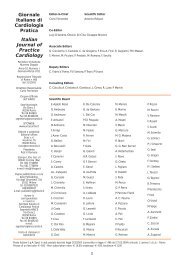Scarica il documento in formato pdf (1196 KB) - ANCE
Scarica il documento in formato pdf (1196 KB) - ANCE
Scarica il documento in formato pdf (1196 KB) - ANCE
Create successful ePaper yourself
Turn your PDF publications into a flip-book with our unique Google optimized e-Paper software.
Giornale Italiano di Cardiologia Pratica - It J Practice Cardiol Dicembre 2007-Marzo 2008<br />
si passa a esam<strong>in</strong>are la derivazione D1; se <strong>in</strong> D1 <strong>il</strong> rapporto<br />
R/S è 1 la cattura non avviene. Infatti nella ris<strong>in</strong>cronizzazione<br />
con cattura del ventricolo s<strong>in</strong>istro <strong>il</strong> vettore<br />
elettrico pr<strong>in</strong>cipale è diretto verso V1 con una morfologia<br />
tipo blocco di branca destra, anche se, considerando<br />
<strong>il</strong> concomitante pac<strong>in</strong>g dall’apice del ventricolo<br />
destro o <strong>il</strong> blocco di branca s<strong>in</strong>istra di base, è raro<br />
avere una immag<strong>in</strong>e da blocco di branca destra completo.<br />
In D1 l’attivazione del ventricolo s<strong>in</strong>istro determ<strong>in</strong>a<br />
una deflessione prevalentemente negativa poiché<br />
<strong>il</strong> vettore pr<strong>in</strong>cipale è diretto da s<strong>in</strong>istra a destra e<br />
si allontana da D1.<br />
La sensib<strong>il</strong>ità di questo algoritmo nell’identificare la<br />
mancata cattura del ventricolo s<strong>in</strong>istro è 94%; la specificità<br />
è 93%; <strong>il</strong> likelihood ratio della risposta positiva<br />
è 12.8; <strong>il</strong> likelihood negativo è 0.06.<br />
BIBLIOGRAFIA<br />
1. Fung JW, Yu CM. Implantable cardiac resynchronization<br />
therapy devices to monitor heart fa<strong>il</strong>ure cl<strong>in</strong>ical status.<br />
Current heart fa<strong>il</strong>ure reports 2007; 4: 48-52.<br />
2. Yoshida K, Seo Y, Yamasaki H et al. Effect of triangle ventricular<br />
pac<strong>in</strong>g on haemodynamics and dyssynchrony <strong>in</strong><br />
patients with advanced heart fa<strong>il</strong>ure: a comparison study<br />
with conventional bi-ventricular pac<strong>in</strong>g therapy. Eur Heart<br />
J 2007; 28: 2610-9.<br />
3. Mc Alister FA, Ezekowitz J, Hooton N et al. Cardiac resynchronization<br />
therapy for patients with left ventricular systolic<br />
dysfunction. A systematic review. JAMA 2007; 297:<br />
2502-14.<br />
4. National Institute for Health and Cl<strong>in</strong>ical Excellence<br />
(NICE). NICE technology appraisal guidance 120. Cardiac<br />
resynchronisation therapy for the treatment of heart fa<strong>il</strong>ure.<br />
May 2007. Http://guidance.nice.org.uk.<br />
5. Leon AR, Abraham WT, Curtis AB et al. Safety of transvenous<br />
cardiac resynchronization system implantation <strong>in</strong><br />
patients with chronic heart fa<strong>il</strong>ure. JACC 2005: 46: 2348-<br />
56.<br />
6. Jungbloed MR, Lamb HJ, Bax JJ et al. Non<strong>in</strong>vasive visualization<br />
of the cardiac venous system us<strong>in</strong>g multislice computer<br />
tomography. JACC 2005; 45: 749-53.<br />
7. Macias A, Garcia-Bolao I, Diaz-Infante E et al. Cardiac<br />
resynchronization therapy: predictive factors of unsuccessful<br />
left ventricular lead implant. Eur Heart J 2007; 28:<br />
450-456.<br />
8. The task force for cardiac pac<strong>in</strong>g and cardiac resynchronization<br />
therapy of the European Society of Cardiology.<br />
Guidel<strong>in</strong>es for cardiac pac<strong>in</strong>g and cardiac resynchronization<br />
therapy. Eur Heart J 2007; 28: 2256-95.<br />
9. Ansalone G, Giannantoni P, Ricci R et al. Doppler myocardial<br />
imag<strong>in</strong>g to evaluate the effectiveness of pac<strong>in</strong>g sites<br />
<strong>in</strong> patients receiv<strong>in</strong>g biventricular pac<strong>in</strong>g. JACC 2005; 39:<br />
489-99.<br />
20<br />
10. Kedia N, Ng K, Apperson-Hansen C et al. Usefulness of<br />
atrioventricular delay optimization us<strong>in</strong>g Doppler assessment<br />
of mitral <strong>in</strong>flow <strong>in</strong> patients undergo<strong>in</strong>g cardiac<br />
resynchronization therapy. Am J Cardiol 2006; 98: 780-5.<br />
11. Porciani MC, Dond<strong>in</strong>a C, Macioce R et al.<br />
Echocardiographic exam<strong>in</strong>ation of atrioventricolar and<br />
<strong>in</strong>traventricular delay optimization <strong>in</strong> cardiac resynchronization<br />
therapy. Am J Cardiol 2005; 95: 1108-10.<br />
12. Vidal B, Sitges M, Merigliano A et al. Optimiz<strong>in</strong>g the programation<br />
of cardiac resynchronization therapy devices <strong>in</strong><br />
patients with heart fa<strong>il</strong>ure and left bundle branch block.<br />
Am J Cardiol 2007; 100: 1002-6.<br />
13. Gaspar<strong>in</strong>i M, Bocchiardo M, Lunati M et al. Comparison of<br />
1-year effects of left ventricular and biventricular pac<strong>in</strong>g <strong>in</strong><br />
patients with heart fa<strong>il</strong>ure who have ventricular arrhythmias<br />
and left bundle-branch block. Am Heart J 2006;<br />
1552: e2-e7.<br />
14. Bleeker GJ, Mollema SA, Holman ER et al. Left ventricular<br />
resynchronization is mandatory for response to cardiac<br />
resynchronization therapy. Analysis <strong>in</strong> patients with echocardiographic<br />
evidence of left ventricular dyssynchrony at<br />
basel<strong>in</strong>e. Circulation 2007; 116: 1440-8.<br />
15. Mollema SA, Bleeker GJ, van der Wall EE et al. Usefulness<br />
of QRS duration to predict response to cardiac resynchronization<br />
therapy <strong>in</strong> patients with end-stage heart fa<strong>il</strong>ure.<br />
Am J Cardiol 2007; 100: 1665-70.<br />
16. Ypenburg C, Roes SD, Bleeker SJ et al. Effect of total scar<br />
burden on contrast enhancement magnetic resonance<br />
imag<strong>in</strong>g on response to cardiac resynchronization therapy.<br />
Am J Cardiol 2007; 99: 657-60.<br />
17. Adelste<strong>in</strong> EC, Saba SS. Scar burden by myocardial perfusion<br />
imag<strong>in</strong>g predicts echocardiographic response to cardiac<br />
resynchronization therapy <strong>in</strong> ischemic cardiomyopathy.<br />
Am Heart J 2007; 153: 105-12.<br />
18. Ypenburg C, Sieders A, Blecker GB et al. Myocardial contract<strong>il</strong>e<br />
reserve predicts improvement <strong>in</strong> left ventricular<br />
function after cardiac resynchronization therapy. Am<br />
Heart J 2007; 154: 1160-5.<br />
19. Bleeker GB, Kaandorp AM, Lamb HJ et al. Effect of posterolateral<br />
scar tissue on cl<strong>in</strong>ical and echocardiographic<br />
improvement after cardiac resynchronization therapy.<br />
Circulation 2006; 113: 969-76.<br />
20. Gorcsan J, Tanabe M, Bleeker GB et al. Comb<strong>in</strong>ed longitud<strong>in</strong>al<br />
and radial dissynchrony predicts ventricular response<br />
after resynchronization therapy. JACC 2007; 50: 1476-83.<br />
21. Diaz-Infante E, Mont L, Leal J et al. Predictors of lack of<br />
response to resynchronization therapy. Am J Cardiol 2005;<br />
95: 1436-40.<br />
22. Vanderheyden M, Mullens W, Delrue L et al. Myocardial<br />
gene expression <strong>in</strong> heart fa<strong>il</strong>ure patients treated with cardiac<br />
resynchronization therapy. JACC 2008; 51: 129-36.<br />
23. Knight BP, Desai A, Coman J et al. Long-term retention<br />
of cardiac resynchronization therapy. JACC 2004; 44: 72-<br />
7.<br />
24. Amman P, Sticherl<strong>in</strong>g C, Kalushe D et al. An electrocardiogram-based<br />
algorithm to detect loss of left ventricular<br />
capture dur<strong>in</strong>g cardiac resynchronization therapy. Ann<br />
Intern Med 2005; 142: 968-73.
















